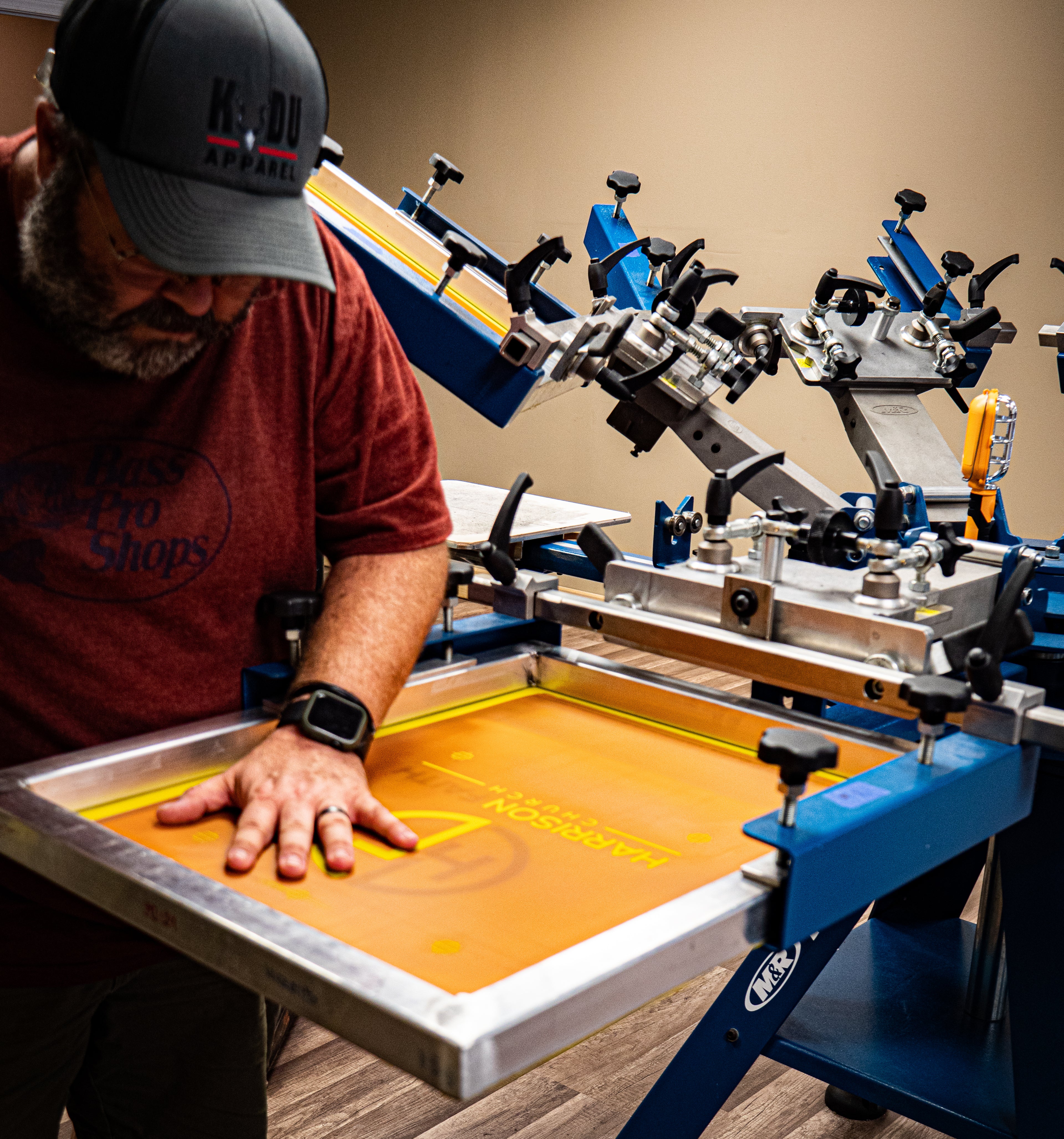Display Printing Uncovered: Whatever You Required to Understand About Tee Shirt and Garment Printing Techniques
Display printing is an interesting approach that combines art with technique, using limitless possibilities for creativity. All set to discover the crucial aspects that make display printing an art type?
The Essentials of Display Printing: Exactly How It Works
When you dive into display printing, you'll uncover it's both a scientific research and an art. At its core, screen printing involves developing a pattern, or screen, that allows ink to travel through only in particular locations (screen printing kit). You begin by selecting your design and preparing your display with a light-sensitive emulsion. When you expose this solution to light, it hardens, leaving your style as a negative area.
Placement the screen over the textile, after that utilize a squeegee to push ink with the display onto the garment. Each step is essential, and grasping them will certainly boost your screen printing skills, transforming basic garments right into one-of-a-kind, meaningful pieces.
Types of Screen Printing Methods
Once you grasp the basics of display printing, it's time to discover the numerous methods that can boost your designs. One preferred method is typical display printing, where ink is pressed with a stenciled display.
If you're going for great details, take into consideration discharge printing. This strategy gets rid of dye from the material, leaving a soft, vintage appearance. Another option is plastisol printing, understood for its sturdiness and dazzling colors, making it a favorite for many brands. Lastly, explore halftone printing to produce slope impacts and detailed layouts. Each technique has its unique beauty, so do not be reluctant to try them bent on discover what suits your style best!
Crucial Tools for Screen Printing
To attain spectacular lead to display printing, having the ideal equipment is essential. You'll require a tough screen printing structure, which holds the mesh that transfers your design onto the garment. Next off, purchase top quality squeegees; these are essential for using ink uniformly across the screen. You'll additionally require an excellent direct exposure unit to develop your displays, in addition to a washout cubicle for cleansing them after usage. A reputable heat source, like a conveyor clothes dryer or warmth press, is vital for curing your prints to guarantee durability. Do not forget an appropriate workspace, furnished with tables and storage space for your materials. Finally, protective gear, such as gloves and masks, will keep you secure from chemicals and inks. With the right devices, you'll be well on your way to producing professional-quality prints.
Choosing the Right Inks and Materials
When selecting inks and materials for display printing, you need to consider the type of ink that works best for your task. Think of textile compatibility to assure your designs look excellent and last lengthy. Discover green ink alternatives to make your printing process more lasting.
Sorts Of Display Inks
Selecting the best screen ink is essential for accomplishing dynamic, sturdy prints that satisfy your project's demands. There are several kinds of screen inks to check out. Specialized inks, such as glow-in-the-dark or metallic, can include one-of-a-kind results to your layouts.

Textile Compatibility Factors To Consider
Comprehending fabric compatibility is vital for achieving top notch screen prints, specifically since various materials respond distinctly to different inks. When choosing inks, consider the textile kind-- cotton, polyester, or blends. For cotton, water-based inks function well, offering softness and breathability. Polyester, on the various other hand, usually requires plastisol inks for much better attachment and dynamic colors. If you're publishing on blends, you may need to use a mix of both kinds. Always evaluate your inks on example textile to guarantee they adhere appropriately and keep color stability. In addition, bear in mind that fabric weight and texture can influence the last end result, so selecting the right ink and material combo is essential for your task's success.
Eco-Friendly Ink Options
Eco-friendly inks are becoming a popular option for screen printers who desire to minimize their ecological influence while preserving quality. When choosing inks, consider water-based inks, which are less damaging and simpler to cleanse up contrasted to standard solvents.
Furthermore, try to find inks made from renewable sources, such as soy or vegetable-based options. By selecting the best inks and products, you'll not only develop spectacular designs but also add to a more lasting printing procedure. Make the button, and your prints will certainly reflect your dedication to the setting!
Preparing Your Style for Screen Printing

File Layout Requirements
To ensure your style looks lively and sharp on fabric, you'll require to pay close interest to file format requirements for screen printing. Make certain your style has a clear history to stop undesirable white sides on your prints. Keep color modes in mind; CMYK is basic for screen printing, so convert your RGB makes accordingly.
Shade Splitting Up Strategies
Shade separation is a necessary step in preparing your layout for display printing, and understanding it can substantially boost your print top quality. You'll require to damage your style right into private shades, as each color needs a different screen throughout printing. This precision not just assures precise shade representation yet likewise streamlines the printing procedure.
Resolution and Size
Attaining the best lead to screen printing starts with assuring your design has the best resolution and dimension. Ideally, your art work should be at the very least 300 DPI (dots per inch) for sharp, clear prints. If you use reduced resolution, your final product could look pixelated and less than professional.
When it comes to size, think about the measurements of your print area. Style your art work to match the final print size, ideally producing it in the real dimensions you'll be publishing. By doing this, you'll avoid any unforeseen scaling issues.
Constantly examine your layout in both vector and raster layouts. Vector graphics can be scaled without shedding quality, making them ideal for screen printing. Preparing properly will ensure your style looks incredible on every garment!
Step-by-Step Display Printing Process
Display printing is a vibrant process that allows you to create dynamic styles on numerous surface areas. To obtain begun, you'll need a display, emulsion, and your chosen ink.
After rinsing the unexposed solution, your screen is ready. Set it up on your printing surface and straighten your garment under it. Put ink onto the screen and make use of a squeegee to push the ink through the pattern onto the material. Raise the display carefully and allow the print completely dry. Treat the ink utilizing warmth to ensure durability. That's it! You have actually successfully display published your style.
Tips for Successful Screen Printing Projects
While you're diving into your screen printing projects, keep in mind that prep work is crucial to success. Start by gathering all your materials-- inks, garments, displays, and mops. A tidy office assists prevent unwanted errors, so clean up prior to you start.
Next, validate your art work is high-resolution and properly sized for your garment. Evaluate your display for proper exposure and clean it completely to prevent spots. When mixing your inks, adhere to the supplier's standards to accomplish the ideal uniformity.
During printing, use also pressure with your squeegee for constant results. Do not hurry; take your time to verify each print meets he has a good point your criteria. After printing, let your garments dry completely before handling or packaging them.
Lastly, constantly keep an example of your job for future referral. By doing this, you can evaluate your development and improve your methods in time. Pleased printing!

Regularly Asked Concerns
The length of time Does It Take to Set up a Screen Printing Work?
Establishing up a display printing job typically takes about thirty minutes to an hour. You'll prepare the displays, mix inks, Check Out Your URL and readjust journalism. The moment differs based on intricacy and experience, so stay organized!
Can I Print on Various Fabric Keys In Using the Exact Same Strategy?
Yes, you can print on different textile kinds using the very same method, yet you'll need to change your settings and inks. Some materials soak up ink in different ways, so trying out guarantees the best outcomes for every material.
What Are Typical Blunders to Avoid in Screen Printing?
When display printing, prevent common blunders like making use of the incorrect ink, disregarding correct direct exposure times, or skipping pre-press checks. Always examine your configuration and preserve clean displays to guarantee high quality results each time.
Exactly How Can I Properly Clean and Maintain My Screen Printing Devices?
To effectively tidy and preserve your display printing equipment, you should consistently wash screens with ideal solvents, check mops for wear, and assure all tools are stored completely dry and dust-free. Uniformity avoids costly fixings and boosts performance.
Is Display Printing Eco-friendly Compared to Various Other Techniques?
Screen printing can be a lot more eco-friendly than other methods, specifically if you use water-based inks and eco-conscious products. By selecting lasting materials and techniques, you reduce waste and minimize your effect on the world.
Display Printing Uncovered: Whatever You Need to Know Concerning Tee and Garment Printing Techniques
At its core, display printing entails producing a stencil, or screen, that allows ink to pass through only in certain areas. Position the display over the textile, then make use of a squeegee to push ink via the screen onto the garment. One prominent approach is typical screen printing, where ink is pushed through a stenciled display.When choosing inks and materials for screen printing, you require to take right into account the kind of ink that functions ideal for your task.
Comments on “Fast Turnaround Custom Screen Printing for Events”